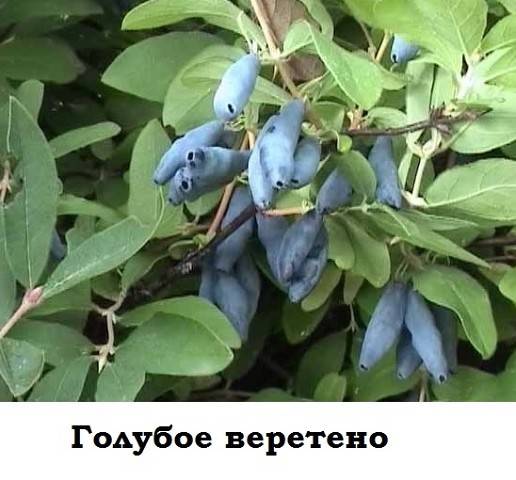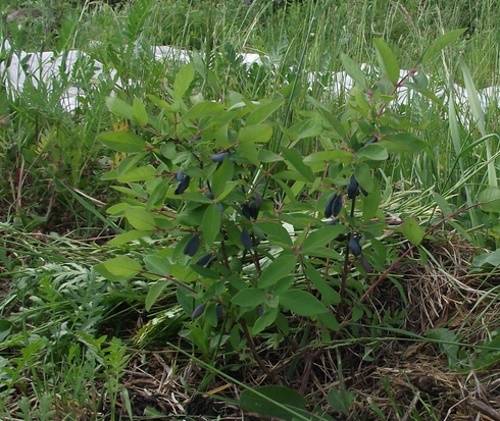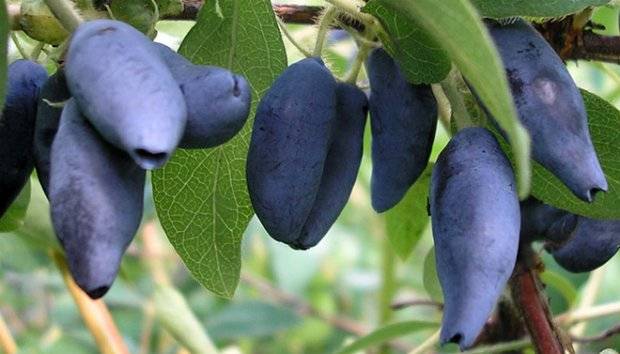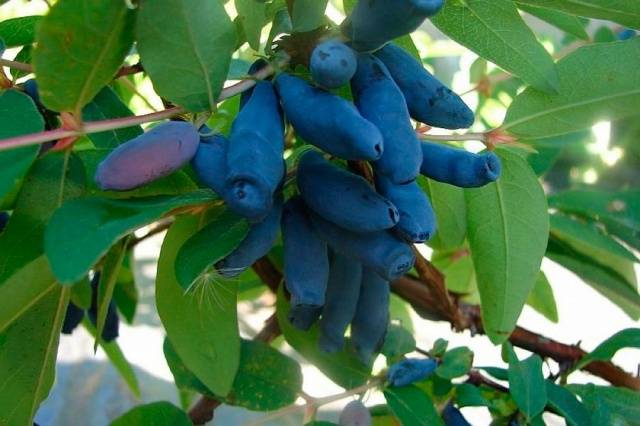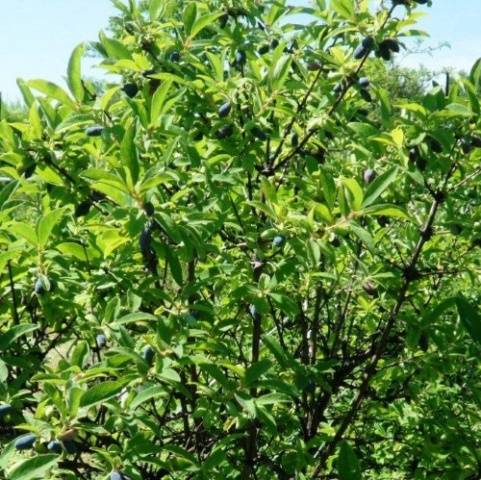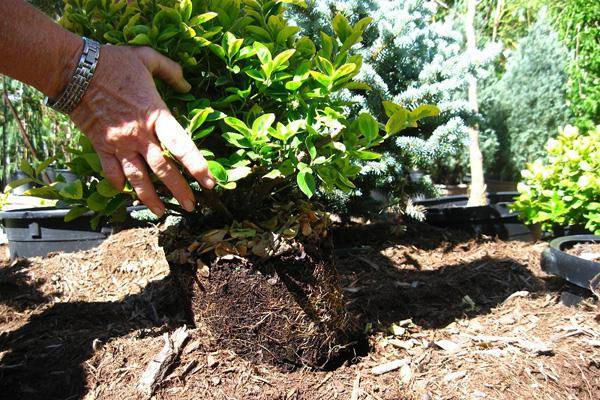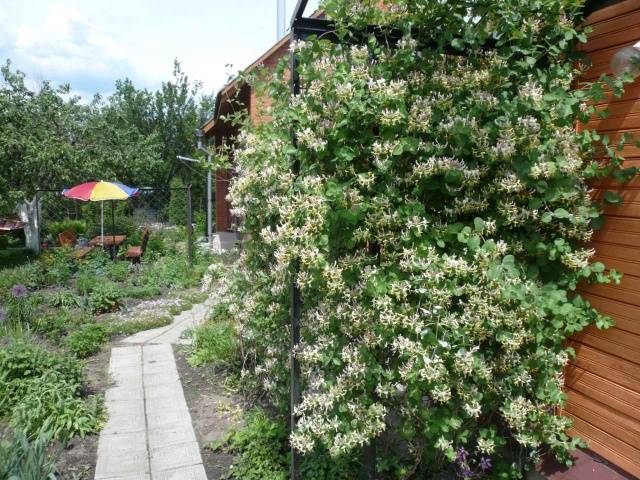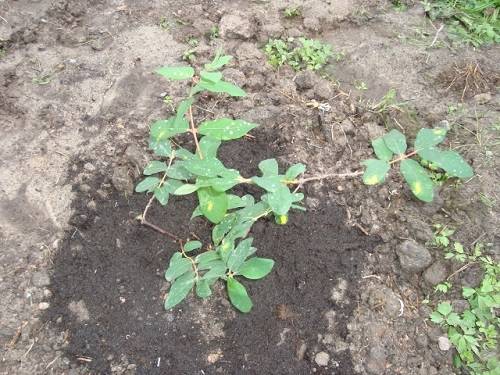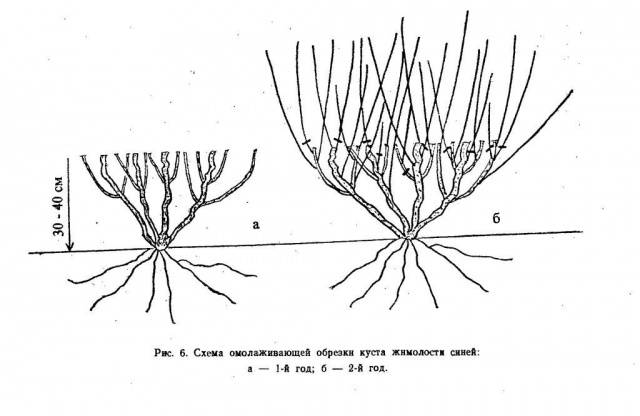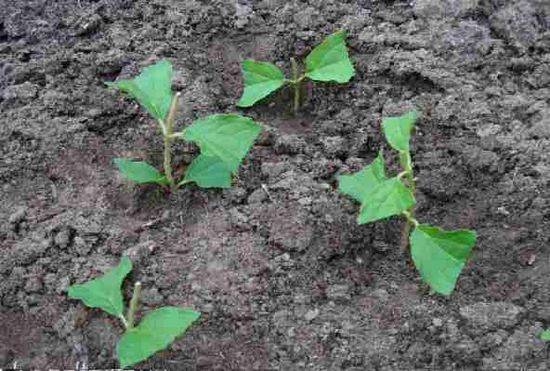Content
Honeysuckle Blue spindle with edible berries is popular among Russian gardeners. Plants are especially appreciated in Siberia, since it was in this climate that the variety was bred. This means that the local conditions for honeysuckle are just what you need.
Breeding history
The blue berry honeysuckle variety is an early ripening plant. The authors are scientists from the Lisavenko Research Institute of Horticulture in Siberia. The seedlings of the Kamchatka honeysuckle Start were taken as a basis, free pollination was used.
Trials of a new variety of honeysuckle began in 1980, and after nine years the plant was included in the State Register of the Russian Federation. The new variety had a compact bush, the yield was not inferior to the parental form.
Description and characteristics of the variety
The first to describe the Blue Spindle honeysuckle were its authors. As planned, it turned out a plant with a height of 80 to 100 cm with a sparse rounded crown.
Bush
The skeletal branches of the Blue Spindle honeysuckle are directed upward at an oblique angle. The plant is represented by thin erect shoots without pubescence. The main color of the stems is green, but under the influence of the sun, the part becomes anthracite.
The Siberian honeysuckle variety has large, elongated-oval leaves of a rich green color. Both parts of the leaf blade (this can be seen in the photo) are sharp at the top and bottom and folded in the middle right along the vein.
On the age trunks of honeysuckle, including the Blue Spindle variety, the bark begins to peel off. This is not a disease, but a feature of the variety.
Fruit
The varietal feature of the Blue Spindle is the size of the berries, which do not change from the region of cultivation. The berries weigh 0.9-1.3 grams, length about 3 cm, diameter 1.1 cm.
The honeysuckle variety got its name due to the shape of the berry, which resembles a long spindle. The base of the blue-blue fruit with a waxy coating is flat, the skin is dense. On the surface of the berry (see photo), transverse tubercles are noticeable.
Berries with a delicate, sweetish-sour pulp. In dry years with a slight bitterness. According to consumers and tasters, the taste of the fruit directly depends on the region of cultivation.
Experts' opinions on the taste of fresh berries of the Blue Spindle variety range from 3.5 to 4.3 points. As for processed fruits, the score is much higher - 4.7-5 points.
Pollinators
Blue spindle honeysuckle is a self-fertile plant. The pollen from the plant itself does not pollinate, the fruit does not set. That is why it needs pollination. If bushes of other varieties of honeysuckle do not grow nearby, fertilization will be minimal. The best pollinating varieties are:
- Cinderella;
- Blue bird;
- Azure;
- Kamchadalka;
- Tomichka.
In the photo below, the Tomichka honeysuckle variety.
Features of fruiting
Fruiting on honeysuckle begins on 4-5-year-old bushes. Berries of the Blue Spindle variety are ready for harvesting in the second half of June. Depending on the region, from the 12th to the 23rd. Ripening occurs unevenly, stretching until mid-June.
Advantages and disadvantages
The creators of the variety took care of the advantages of the plant, thanks to which honeysuckle is popular:
- Early ripening.
- Excellent yield regardless of the growing region. About two kilograms of gray fruits are harvested from the bush annually.
- The Blue Spindle variety attracts with its large tasty berries.
- The bushes are compact, unpretentious to care for, do not need shelter for the winter.
- Drought-resistant and frost-resistant. Withstand temperatures up to - 45 degrees, the fruits are tied even at 8 degrees of frost.
- They practically do not get sick and are not affected by pests.
If we talk about the shortcomings, then they are minimal:
- the appearance of bitterness in berries in dry years;
- shedding, which leads to a loss of 10-15% of the crop.
Growing
There are no special secrets for growing honeysuckle bushes, there are only some nuances that novice gardeners should get acquainted with.
What is honeysuckle for in the garden, find out from the video:
How to choose seedlings
For planting, seedlings of blue spindle honeysuckle are required at the age of two years. You need to purchase them in nurseries. And now about how to choose the right seedling:
- When buying a plant, pay attention to the development of the roots.
- You should not take cuttings short up to 25 cm, as they are still underdeveloped.
- Sick honeysuckle bushes with broken branches should also be avoided.
- If the height of the seedling is more than one and a half meters, then they do not take root well. And fruiting does not begin immediately, since the seedling is under severe stress from the transplant.
Landing dates
When planting blue spindle honeysuckle bushes, you need to take into account the peculiarities of growing a seedling:
- If the root system is open, then planting is planned for the fall, 30 days before the cold weather. The seedlings are frost-resistant, they are not afraid of frost up to 45 degrees. In the spring, such bushes should not be planted, because the blooming of the leaves begins early. The plant should spend all its strength on building up green mass and shoots, and the root system will not be able to develop. As a result, the bushes begin to hurt and die.
- Honeysuckle seedlings Blue Spindle with a closed root system can be planted at any time of the year.
Site and soil selection
In one place, the Blue Spindle honeysuckle bears fruit for up to 20 years, so you need to immediately decide on the site. Plants like a well-lit, sunny, draft-free location. The site must be protected from the harsh wind knocking down buds and berries. In the photo, honeysuckle is planted against the wall of the house.
The root system is capable of ruining highly suitable groundwater. When choosing a location, you need to take into account that they should not be higher than one meter from the surface.
Although the honeysuckle variety is unpretentious, the soil in the planting hole should be well filled with nutrients. Experienced gardeners recommend laying dry branches, chips, which not only feed the plant during decay, but also warm the root system.
Planting a bush
The further development of the plant and fruiting depends on the correct planting of the seedling:
- The size of the hole should be 40x50 cm. The hole can be made larger, it all depends on the root system.
- Drainage is laid at the bottom, then fertile soil, mixing it with a compost bucket, 300 gr. ash, 30 gr. potassium sulfate and 100 gr. superphosphate.
- The root collar of the honeysuckle seedling is buried 5-7 cm higher than it grew in the nursery. The roots are straightened and covered with soil up to half. Immediately pour out a bucket of water so that the root system straightens out.
- After the hole is filled to the top, the soil is tamped down and another bucket of water is poured out. To make the moisture evaporate more slowly, the surface under the Blue Spindle bush, as shown in the photo, is mulched with a layer of 5-7 cm.
Care
According to gardeners who have been involved in culture for more than one year, caring for honeysuckle does not leave much difficulty. The main thing is to carry out the basic agrotechnical measures.
Watering
As noted in the description, the plant is drought tolerant. Berries of the Blue Spindle variety are edible, but with a lack of moisture, bitterness appears in them.
Watering is especially important during flowering and fruit ripening. You need to water the bushes weekly, under each bush you need 4-5 buckets of water.
Top dressing
Blue spindle honeysuckle is a perennial plant and needs timely feeding:
- Fertilizer is applied for the first time in early spring, as soon as the ground begins to thaw. Half a bucket of compost or humus mixed with mulch is poured under each bush. Exactly the same top dressing can be applied in the fall, after the leaves have flown around.
- The second time, the bushes are fed with wood ash (1/2 cup) under each plant during the budding period and in August, when the buds are laid.
- In autumn, when plant growth stops, a groove is made around the bush at least 20 cm in depth and fed with 1 tablespoon of superphosphate. Then flatten the groove and water.
Pruning
If you do not form a bush, then after 3-4 years the crown will become too thick, which will negatively affect fruiting. After 2-3 years, the apical buds die off, but intensive growth of lateral branches begins.
Pruning Secrets:
- Sanitary pruning of Blue Spindle Honeysuckle is required for the first six years. It is performed in autumn and early spring. With sanitary pruning, all shoots that grow in the middle of the bush are removed so as not to shade the crown. It is carried out every 2-3 years, the skeletal branches are shortened by a third.
- In the future, in addition to sanitary pruning, thinning is necessary. It is held in late autumn.
- Old shoots need to be cut at the base on a stump of 7-8 cm. Next year, replacement shoots will appear on them.
- To rejuvenate the bush, it is necessary to cut off all the shoots on a stump (as in the photo) so that new shoots grow, because fruiting is on them.
Protection against diseases and pests
The Blue Spindle variety, judging by the description and reviews of gardeners, is resistant to many diseases and pests. Although there are fungal diseases that plants need to be protected from. Honeysuckle is affected:
- reddish olive blotch;
- blackening of the branches;
- powdery mildew;
- tuberculariosis;
It is impossible to fight viral diseases, but to protect against fungal diseases, you can use a 3-4 percent solution of Bordeaux liquid or the drug Skor.
The blue spindle honeysuckle suffers greatly, according to gardeners, from the caterpillars of the honeysuckle fingerfly, which infect the berries. No less harm is caused by insects that damage the leaves.
To combat harmful insects, use:
- Decis;
- Inta-Vir;
- Aktellik;
- Confidor.
Reproduction
Home seed propagation is not suitable for honeysuckle. The fact is that the seedlings are too delicate and weak, almost all die. If they do survive, then, most likely, wild animals that will give the first harvest in 5 years. But the berries will be inedible.
Plants can be grown from young annual shoots.
They are plucked with a heel from the mother bush in June and rooted in the greenhouse. Although this is also a dubious option, especially for beginners. The fact is that for a whole month, plants need high humidity, which is not always possible.
Learn how to propagate honeysuckle with green cuttings from the video:
Conclusion
Honeysuckle berries are highly valuable because they contain a large amount of vitamins. Honeysuckle fruits are especially useful for older and middle-aged people.P-active substances have a beneficial effect on the cardiovascular system, help cleanse blood vessels, and increase their elasticity.
